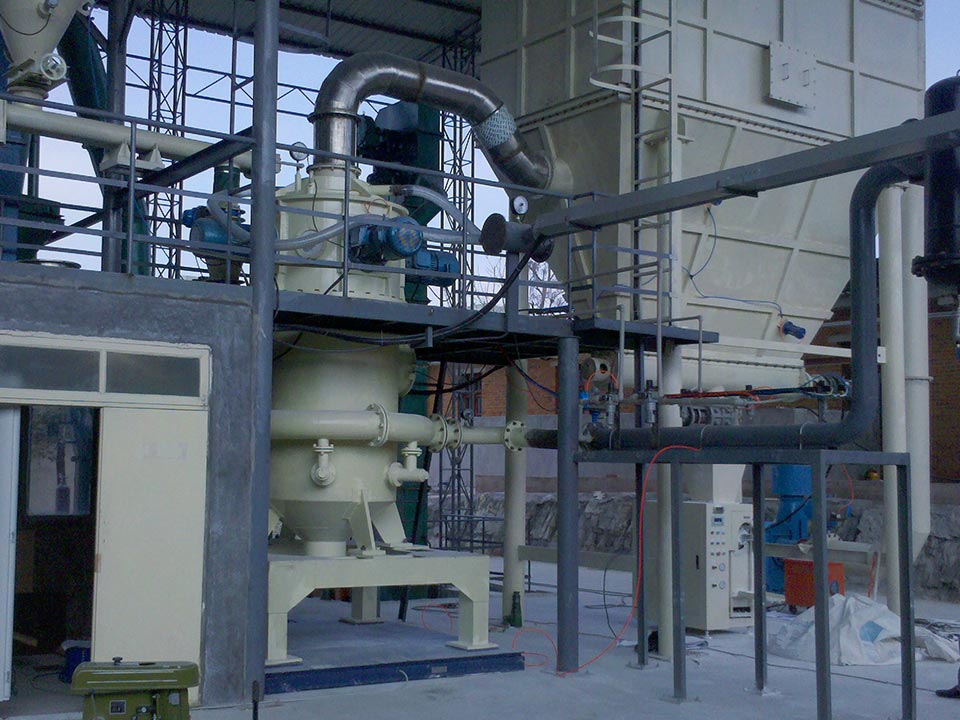Factors affecting the production efficiency of fluidized bed jet mill
The fluidized bed jet mill, in the dry mill, has a simple structure and can realize continuous feeding and discharging. It will neither make the material too fine nor too thick. Only materials of qualified size can be used. It is delivered continuously and timely, and its particle size distribution is steep.
Due to the crushing principle of this model, a specially designed nozzle generates a supersonic high-speed airflow. Under the acceleration of the supersonic airflow, the materials to be crushed collide, squeeze and rub against each other and are instantly crushed at the intersection of the nozzles. Since the material does not violently collide with internal parts such as the vessel wall, the equipment is durable and more importantly, it ensures the high purity of the material after crushing. Another important feature is that the gas ejected from the nozzle forms adiabatic expansion in the crushing chamber, and the temperature of the material will not rise during the crushing process. On the contrary, the material is pulverized instantly at low temperature. This pulverization method can pulverize heat-sensitive materials without adding additional refrigerant, and it can also ensure that its physical and chemical properties remain unchanged.

However, the energy consumption per unit output of the fluidized bed jet mill is relatively high. Although this model has many advantages, it still seems to be overburdened for products with low added value.
Nevertheless, people still place great enthusiasm and expectations on the fluidized bed jet mill. Some scholars believe that if the working efficiency of the fluidized bed airflow ultrafine pulverizer can be increased by 1 to 2 times, it will be a very meaningful thing. Due to the improved working efficiency of this model, it will open up a wider range of applications. prospect.
In our long-term experience in the research, development and use of fluidized bed jet mills, we have accumulated a certain amount of practical experience.
If you want to improve the working efficiency of the jet mill, you should first consider two parts, that is, the mill itself and its operating conditions.
(1) Strictly control the feed volume: the feed speed should be appropriate and uniform. In addition, we must also consider which feeding method to use. Some materials need to use a screw feeder, and some materials need to be oscillated. The feeding method should be determined according to the characteristics of the material itself. The most important thing is to ensure that the energy in the crushing room is continuously supplied with materials to meet a certain concentration of materials in the crushing room. Practice has proved that whether the material concentration is too low or the material concentration is too high, it will have an adverse effect on the output of the finished product. The material concentration is low, the probability of contact between materials is small; the material concentration is high, which will affect the airflow speed, both of which are not conducive to the improvement of efficiency. The feed rate of the material should be strictly controlled according to the air pressure, material characteristics and the characteristics of the body itself.
(2) Increase the air velocity and the probability of particle impact. This must be agreed from two aspects. First of all, the nozzle design must be reasonable, and the nozzle layout is also very important. Only by meeting the above two requirements can the goal of improving production efficiency be achieved.
The jet mill breaks the traditional mode of setting nozzles. In the same plane of the crushing chamber, it forms a certain angle with this plane, and several nozzles are arranged symmetrically downwards. In addition, at the bottom of the crushing chamber, the opposite is set A vertically upward nozzle, and the center line of the other nozzles, point to the same focal point. Under the combined action of the air currents ejected from all nozzles, the materials form a conical shape and gather at the focal point, and the materials are instantly crushed. In addition, a mixing tube is installed in front of the nozzle, so that there is no blind zone in the crushing chamber, and the impact probability of particles is increased. Only this modification can increase the efficiency by 150-200%.
(3) Optimize the hierarchical structure. Classification is a crucial part of the ultrafine pulverization system. One of the most notable features of the fluidized bed jet mill is that it can realize continuous feeding and discharging, preventing the material from being finely crushed and causing unnecessary energy consumption. According to the principle of turbine classification, appropriately increasing the diameter of the classifying wheel, increasing the speed, and reducing the air flow are the fundamental guarantees to ensure that the classifier separates the particle size. The relationship between the above three should be controlled according to the characteristics and specific requirements of different materials.
(4) The original material entering the jet mill should be as small as possible. In order to achieve this goal, an ordinary grinder should be used for pre-crushing treatment before ultra-fine pulverization. This is the most direct and effective method to save energy and increase unit output.
(5) Ensure that the fluidized bed jet mill, the airtightness requirements of the entire closed system, including the fully enclosed devices of pipelines, valves, and equipment, should not leak. In short, it is necessary to concentrate precious aerodynamic energy on the nozzles, and strive to increase the gas flow rate and pressure.
(6) The product collection and dust collector should ensure smooth air supply and should not have excessive resistance. This part of the system equipment must not only ensure the collection of qualified products, but also ensure that the environmental requirements are not polluted, but after the equipment is too complicated, things will bring too much burden to the overall work.
